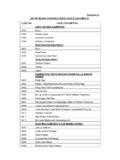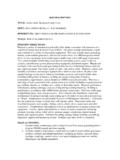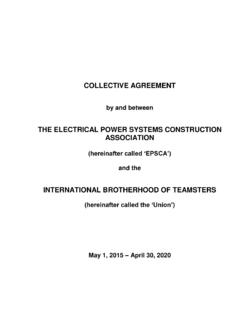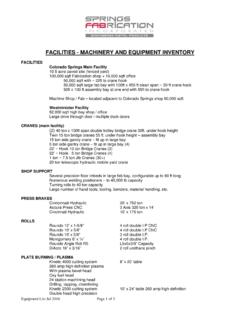Transcription of New frontiers of DGA interpretation for power transformers ...
1 New frontiers of dga interpretation for power transformers andtheir accessoriesMichel DuvalHydro Quebec IREQ Varennes J3X1S1 CanadaABSTRACTD issolved gas analysis is among the most powerful tools for assessing the condition oftransformers and their accessories in service. However, several questions still remain todayconcerning the use of DGA, such as: how much is the equipment at risk, what are the actionsrecommended, and how can DGA be applied to related equipment such as load tap changers?The latest investigations concerning these questions are presented and discussed in this of Failure of TransformersThe risk of failure of transformers in service, based on dissolved gas analysis (DGA), dependson three main parameters: the type of fault involved, the location of the fault (in oil or in paper),and the amount of gases formed (concentrations and rates).
2 The most dangerous faults are: high-energy arcing faults D2 in oil and paper, low-energy arcingfaults D1 in paper, and hot spots in paper of high temperatures T3 and dangerous faults are: low-energy arcing faults D1 in oil, hot-spots T3 and T2 in oil, and hotspots in paper of low faults are: hot spots T1 in oil, producing only stray gassing of oil, coronapartial discharges PD (unless very high levels of hydrogen are formed), catalytic reactions withwater, and aging of of Type and Location of FaultsThe general type of fault (PD, D1, D2, T1, T2, T3) can be identified by several methods: ,Rogers, Key Gas, IEC ratios, Duval Triangle is more difficult, however, to identify the location of the fault (in oil or in paper); the levels ofCO, CO2 and the CO2/CO ratio are generally used for that purpose. However, it has beenshown recently [1] that these gases are not always good indicators.
3 More particularly, largeamounts of CO (>1000 ppm) and low values of the CO2/CO ratio (< 3) are often observed inclosed transformers without any fault [2]. This has been attributed at CIGRE to the lowavailability of O2, which favours the formation of CO over , localized faults involving small volumes of paper often do not produce detectable amountsof CO and CO2 against the usually large background of these gases in oil. In many cases, localfaults with carbonization of paper are more reliably detected by the formation of the other gases(H2 and hydrocarbon), using for example Duval Triangles 4 and 5 [3].The Duval Triangles 4 and 5 The classical Duval Triangle 1 uses gases (CH4, C2H4 and C2H2) that are formed by faults oflow to high energy (from low-temperature faults T1 and PD to high energy arcing faults D2).
4 The Duval Triangle 4 uses gases (H2, CH4 and C2H6) that are formed more specifically by faultsof low energy or temperature (PD, T1 and T2), in order to get more information about thesefaults in service. An updated (2012) version of Triangle 4 is presented in Figure Interpretation1 of 8 Warning: Triangle 4 should be used only for faults identified first with Triangle 1 as faults PD, T1or T2. It should never be used in case of electrical faults D1 or 4 is used mostly to distinguish between:-stray gassing of oil at T < 200 C in zone S,-overheating at T < 250 C in zone O with cooking but no carbonization of paper,-possible carbonization of paper at T > 300 C in zone C (in 80% of inspected cases used forTriangle 4 - not 100%),-corona partial discharges in zone PD. The boundary between zones PD and S has beenchanged recently from % C2H6 = 1 to , based on stray gassing test results on new types ofoil on the market.
5 -in case of a DGA point in service in the PD zone with a % C2H6 slightly < ( , ), verify the stray gas formation of the oil used with laboratory stray gassing tests beforeconfirming a fault PD or 1: The Duval Triangle 4 Figure 2: The Duval Triangle 5(Graph Courtesy Serveron)The Duval Triangle 5 uses gases (CH4, C2H4 and C2H6) that are formed more specifically byfaults of high temperature, in order to get more information about thermal faults in paper and inoil. An updated (2012) version of Triangle 5 is presented in Figure : Triangle 5 should be used only for faults identified first with Triangle 1 as faults T2 orT3. It should never be used in case of electrical faults D1 or 5 is used mostly to distinguish between:-hot spots in oil only in zones T3 (> 700 C) and T2 (> 300 C),-possible carbonization of paper in zone C (in 90% of inspected cases used for Triangle 5 - not100%).
6 -for faults O, S and PD, Triangle 4 should be used rather than Triangle small, free algorithm is available from for Duval Triangles 1 through aging Myths and Reality1 The risk of failure of transformers increases with age and load. Interpretation2 of 8 However, in a large majority of cases this is because of high moisture, gas-producing faults,leaking gaskets or membranes, rusting of tank, loss of dielectric properties of paper and oil, notbecause of paper When the degree of polymerization (DP) of paper reaches a value of 200, the risk of failure ofthe transformer becomes very high: large number of transformers with DPs between 200 and 100 have been reported to operatequite normally, including by the late V. Sokolov [4].Furthermore, no convincing cases have been reported so far (to CIGRE WG47 or elsewhere) oftransformers with a DP of 200 or 100 where failure could be clearly attributed to the mechanicalweakness of , based on present observations, the risk of failure of transformers with low DPs appears tobe quite low, and not very high as generally believed.
7 transformers with gas-producing faultsare actually much more at risk of When paper reaches a DP of 200 or 100, it becomes brittle and will be easily torn away frombetween windings turns, causing short circuits: squeezed between turns will remain in place because of the compression/ clampingforces applied to windings, even when it is brittle and has a low tensile is required for paper between turns is compression strength, not tensile strength. Brittlepaper can easily resist compression forces down to very low DPs ( , 50).4 Aged paper loses density and thickness, resulting in loose windings. , however, can easily be mitigated by re-clamping windings, which by the way should bepart of regular maintenance after 20 to 30 years in When paper reaches a DP of 200, external short circuits will result in immediate failure.
8 Following case was reported by ERDF to the MyTransfo Conference in Torino in 2010. Oneof their transformers with a DP of 150 was transported to the factory and subjected to severalexternal short circuits, but did not A DP of 200 is a good indicator of the end-of-life of transformers : the absence of gassing or high moisture, transformers with a DP of 200 in most cases couldbe left in service several more years, based on present observations Conclusion:Priority should be given to the replacement of faulty gassing transformers that cannot be replacements based on DP only, a limit value of 100 or 150 appears more realistic than limits in serviceGas limits in IEEE Gas Guide are presently under revision, based on the very largedatabase of DGA results put together recently by the IEEE WG. One very significant change willconcern condition 1 values for CO and CO2, which will be much higher (750 and 7500 ppm,respectively) and closer to CIGRE/ IEC limits.
9 Present IEEE limits are often a cause of distinction between closed and open type transformer will be attempted by the WG, using theratio R = O2 / (O2 + N2) which is usually much lower in nitrogen-blanketed types. Low values ofthe ratio, however, may also be due to oil for gas concentrations and rates above IEC typical (condition 1) values have beenrecommended by CIGRE TF15/WG32 [5], together with more frequent sampling intervals Interpretation3 of 8 CIGRE WG47 is presently investigating the effect of type and location of faults on these gaslimits. The effect on typical (condition 1) values is obtained by calculating 90% percentile valuesfor each type of fault. The effect on prefailure (condition 4) values is deduced from inspectedfault cases where high levels of gases are observed without failure or just before general type of fault is identified first with Triangle 1 (PD, D1, D2, T1, T2 or T3).
10 Triangles 5and 4 are then used for further distinctions between faults T3/T2 in oil or with carbonization ofpaper, overheating, stray gassing and corona of the effect of fault type on condition 1 and condition 4 are indicated in Table 1 andsummarized in Table 3 for condition 4. Also see Figures 3 and , condition 1 will require more frequent monitoring by DGA, while condition 4 mayrequire inspection and repair of the 1 Effect of Fault Type and Location on Conditions 1 and 4 (values in ppm)Type of fault AllCorona PDsType of fault AllT3 in paper H2H2 C2H4C2H4 Condition 1 10015,000 Condition 1 50300 Condition 4 72533,000 Condition 4 8004800 Type of fault AllStray gassing Type of fault D1 in oil D1 in paper H2H2 C2H2C2H2 Condition 1 100300 Condition 4 430120 Condition 4 72517,000 Type of fault AllT3 in paper Type of fault AllT3 in oil C2H4C2H4 Condition 1 50200 Condition 4 80025,000 DGA Interpretation4 of 8 Fig.








